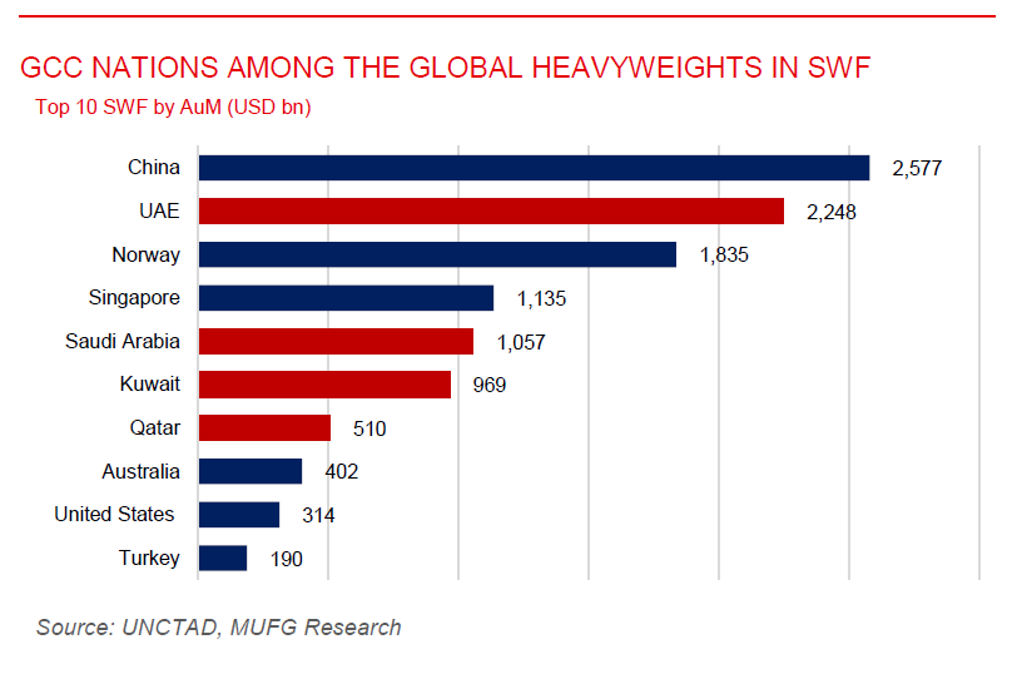To read the full report, please download the PDF above.
Middle East Daily
SOOJIN KIM
Research Analyst
DIFC Branch – Dubai
T: +44(4)387 5031
E: soojin.kim@ae.mufg.jp
MUFG Bank, Ltd. and MUFG Securities plc
A member of MUFG, a global financial group
Middle East Daily
COMMODITIES / ENERGY
Oil holds near two-month low on IEA oversupply forecast and US-Russia summit watch. Oil prices steadied near a two-month low after the International Energy Agency warned that global crude markets are track for record oversupply in 2026, with inventories expected to build faster than during the pandemic year of 2020. Brent hovered around USD66/b and WTI near USD62/b, pressured by OPEC+’s full reversal of 2023 output cuts and rising non-OPEC supply, especially from the Americas. The market is closely watching the upcoming US-Russia summit, which could influence sanctions on Russia’s oil exports. However, slowing economic growth beyond peak driving season and an expanding surplus continue to weigh on sentiment. The US Energy Information Administration reported a 3 million barrels increase in nationwide crude stockpiles last week, the highest in two months.
Gold extends gains on rising Fed rate cut bets. Gold prices rose for a third consecutive session, trading near USD3,370/oz, as expectations for Fed rate cuts strengthened following comments from Treasury Secretary Scott Bessent urging a 1.5ppt reduction in borrowing costs. Falling Treasury yields further supported gold, which benefits in low-yield environments. Market sentiment has shifted notably from last month, with consensus now leaning toward a September quarter-point cut and some anticipating a larger move. Gold has surged 28% this year, mainly in the first four months , driven by geopolitical tensions, trade uncertainty, and strong central bank purchases. Investors remain alert for official confirmation on whether US gold bar imports will face tariffs, after recent confusion temporarily widened the futures-spot price premium before President Trump signalled no levy, narrowing the gap.
MIDDLE EAST - CREDIT TRADING
End of day comment – 13 August 2025. A wise market observer once noted that when JPEIGLSP Index is above 400bps one should only be long or flat, and when it is below 300bps one should only be short or flat—the challenge being knowing when to ignore these rules. While current levels are historically tight on an absolute basis (tightest since December 2012), on a relative basis—particularly versus US IG and EM HY relative to EM IG—there may still be room to run. Historically, in years when the index tightened in August, only four saw further tightening in September, with the other three exceptions occurring in 2020–2022. From these levels, December 2012 ended at 265bps before widening for three straight months to 307bps in March 2013, though this may not provide a clear guide. New issuance season in September could be strong for DCM desks, potentially capping further spread tightening, but in the meantime, 250bps remains within reach. Liquidity challenges persist, with small trades resetting prices upward by over a point due to minimal market participation and limited pushback on new bid levels.
MIDDLE EAST - MACRO / MARKETS
Saudi PIF’s assets surge despite decline in returns. Saudi Arabia’s Public Investment Fund (PIF) strengthened its position as a global leviathan in sovereign wealth management, growing assets under management by 19% y/y to USD913bn in 2024. Despite the asset surge, boosted in part by an enlarged stake in Aramco, annualised returns slipped to 7.2%, down from 8.7%. a significant USD8bn write-down across flagship “gigaprojects” such as Neom was recorded, reflecting higher costs, strategic realignments, and operational delays amid fiscal constraints. Net profit was sharply hit, tumbling 60% to USD6.9bn. The fund continues to drive Vision 2030’s transformation agenda, deploying nearly USD57bn across priority sectors and broadening its impact, now accounting for 10% of non-oil GDP via 225 portfolio companies. Concurrently, it shifted its funding structure with new public and private debt raises while managing lower cash reserves of around USD60bn.
Arab Monetary Fund projects stronger regional growth amid cooling inflation. The Arab Monetary Fund projects the Arab region’s economy to grow by 3.8% in 2025 and 4.3% in 2026, up from 2.2% in 2024, supported by stronger macroeconomic fundamentals, diversification strategies, and structural reforms, despite global trade tensions and regional uncertainties. GCC economies are expected to lead with growth of 4.0% in 2025 and 4.4% in 2026, driven by non-oil sector expansion and infrastructure investment, while oil exporters like Algeria, Iraq, Libya, and Yemen are forecast to expand by 3.3% and 3.8% over the same period due to improved production and investment-friendly policies. Oil-importing states will benefit from fiscal reforms, lower public spending, and accommodative monetary policy. Regional inflation is set to ease from 31.9% in 2024 to 20.8% in 2025, with further moderation to 14.2% in 2026, or 7.6% excluding high-inflation economies, aided by lower commodity prices, effective monetary measures, and currency stability.

